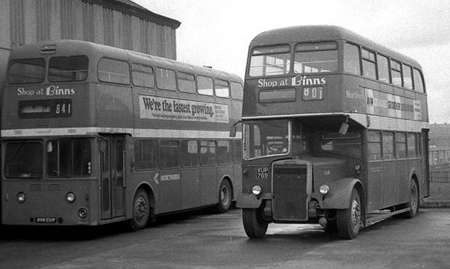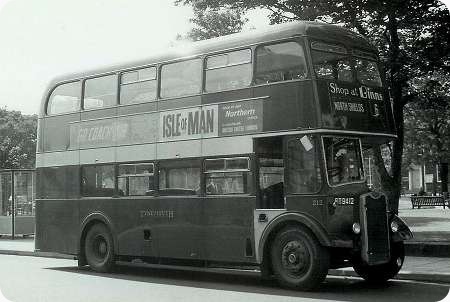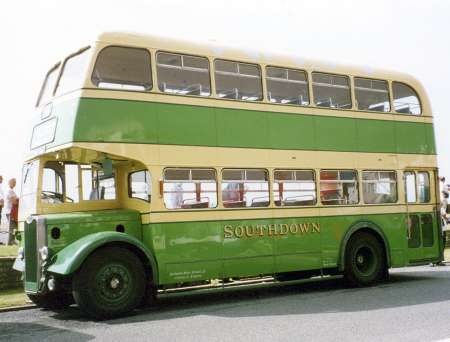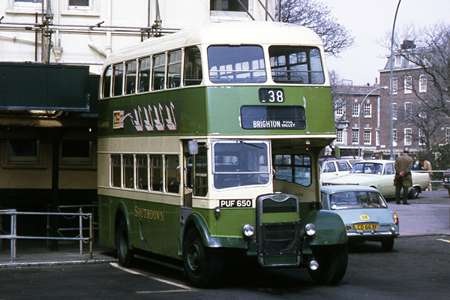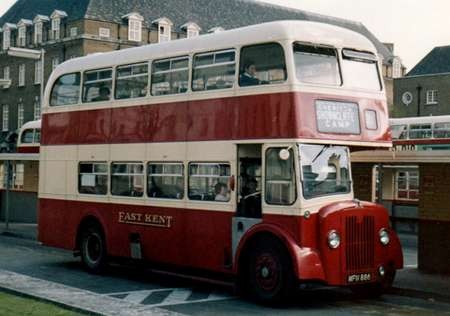Northern General – Leyland Titan – VUP 761 – 1761
Northern General Transport
1957
Leyland Titan PD2/12
Park Royal H35/28RD
Pictured outside Consett Depot, VUP 761 is a Park Royal bodied H35/28RD Leyland PD2/12, it was the first in a batch of ten delivered in 1957 – VUP 761/70; We have seen Northern General Transport vehicles with the open platform version of this type of Park Royal body before on this site, the previous ones being the Guy Arab IV’s of Tynemouth and District. The order for these handsome vehicles was initially placed by Sunderland District Omnibus, but prior to delivery they were diverted to Northern and entered service as 1761/70, so I don’t know if any of them got as far as being painted in SDO livery. They were generally to be found earning their keep on the long routes to Darlington and Stockton/Middlesbrough that NGT shared with United, where they were eventually superseded by the Routemasters. 1761 is still looking very smart, but going by the lettering and livery style it was probably nearing the end of its service life at the time this photo was taken, but I don’t think any of these vehicles suffered the indignity of being painted in NBC poppy red.
Photograph and Copy contributed by Ronnie Hoye
20/12/13 – 15:51
I didn’t ever encounter these particular buses, but the combination of the dependable and stolid PD2 chassis with the stylish and well finished Park Royal bodywork of the time always formed a sound and efficient piece of capital equipment. The reputation that Leyland double deckers acquired from the TD1 through to the PD3 was entirely merited, and Park Royal bodywork, until it descended from the sublime to the ridiculous, was always a sound choice. Buses like these attained a level of reliability that present day bus engineers can only dream about.
Roger Cox
20/12/13 – 16:43
Couldn’t agree more, Roger.
David Oldfield
20/12/13 – 17:58
It’s called rugged simplicity lads. There’s a lot to be said for power steering and fully automatic gearboxes -especially when the driver has to collect fares, ensure the passengers are safe and watch out for top deck vandalism – self diagnostics can be a boon to the engineers and heaters, fluorescent lights and high visibility grab rails with low floor accessibility might be great for passengers but the modern bus for all its sophistication is a potential nightmare when it goes wrong.
Phil Blinkhorn
21/12/13 – 07:13
…..and so say all of us, Phil…..
David Oldfield
21/12/13 – 07:13
Power steering can also be a bad thing, Phil. Our half cabs a Percy Main were well maintained, and although heavier, they were perfectly acceptable, and at least they had ‘feel’ whereas the MK1 National was a nightmare on a wet or slippery road. Half the time you didn’t have a clue where the wheels were pointing, and it was more by luck than judgement if you went in the direction you intended to go.
Ronnie Hoye
21/12/13 – 08:32
Only drove a Mk1 National once in good conditions. Light and vague sums up the handling!
David Oldfield
21/12/13 – 13:58
A bendy is even worse, gents! Imagine putting the foot down for a standing start on a frosty morning, and seeing – via your mirrors – the back end advancing sideways towards the wall of a nearby property, while the front end just sits there. I know of one instance in Southampton and I’m sure it isn’t unique . . .
Pete Davies
21/12/13 – 13:58
Notwithstanding all the supposed development work and the well publicised testing in near arctic and sub tropical climes, the National MkI was appallingly unbalanced design with very poor front/back weight distribution. Its one saving grace was the almost indestructible bodywork. Some of the early 11.3 metre production examples went to London Country who, despite the dual door configuration, put the things on the Stevenage Superbus, thereby applying to that ‘premium’ service its first kiss of death. Hatfield and Dunton Green garages were next to receive these bundles of joy for local bus routes. By now Leyland had relaxed its rigid stance and agreed to produce a single door option, and, despite the ultra basic bus seating, a batch of these gems went on Green Line routes 721. 706 and 711. I never drove a National; at this time I worked in the LCBS HQ next to Reigate Garage, where the vicissitudes of the LN were well known. The introduction of these things coincided with a spell of extremely hot weather which caused some kind of meltdown in the gear selection/control mechanism. Also, the misconceived microswitches in the engine cover required someone to push the back panel hard to enable engine starting – it was said that the National was the only bus that needed a boot up the backside to make it go. I did often ride on these early Nationals, and found them to be utterly nasty. Drivers had never experienced such rapid engine acceleration before, and progress consisted of a succession of savage starts and violent stops. The body roll on corners was extreme, requiring passengers to clutch at the handrails to avoid being deposited in the gangway. The very light steering coupled with the long rear overhang behind the back wheels led to a spate of rear end collisions due to the backswing. The much hyped heating system, the rearward pod roof location of which added to the weight imbalance of the design, must have been created by someone with no knowledge of simple physics, since hot air rises everywhere except, apparently, in Leyland, Lancashire. The roof interior soon became Henry Ford’s preferred colour. Certainly the National did improve with time, but the 500 series engine was always a lemon. The MkII addressed several of the problems, but it could never match up to the Bristol RE that Stokes deliberately killed off to boost National sales.
Roger Cox
21/12/13 – 15:22
Brilliant resume of the National, Roger. I am a little more generously inclined to the MkII – but there was no excuse nor was it a substitute for the Series III RE that never was.
David Oldfield
21/12/13 – 18:04
And how did the Lynx measure up to the Nationals I & II?
Chris Hebbron
22/12/13 – 07:17
Lynx? Swearing and bad language should never be allowed on this site.
David Oldfield
22/12/13 – 07:18
It would be fascinating to know just what the warranty arrangements were for the Mk1 Nationals. They were either a nightmare or a milch cow for Leyland judging by the throughput of spares at the Chorley operation in the first few years. There was many an old Leyland hand seen shaking their head and muttering about the legitimacy of the type.
On a different tack, just what is it that the Brits don’t like about articulated PSVs? They operate successfully all around the world, including in many countries where snow and ice reign for far longer than in the UK. Certainly those with the power pack driving the rearmost wheels are harder to control in certain conditions but I can’t recall hearing such criticism of the breed anywhere else.
Phil Blinkhorn
22/12/13 – 08:46
Is it the "London Transport Syndrome", Phil? We didn’t invent it, we didn’t design it so we won’t make any effort to make it work. Oh, and whilst we’re at it, we’ll draw attention to the slightest fault – conveniently glossing over any faults in our own designs.
I’m a firm believer in the RM – having both ridden and driven numerous examples. It is fairly well documented, however, that there were numerous teething problems – which were eventually sorted out. [Pride wouldn’t let us design a dog.] The MB and DM(S) weren’t designed by LT, so could be jettisoned as rubbish and failures – but like the Cravens RTs they had long and honourable lives post LT. The Bendis fall into this category. They are not British – and therefore not worth consideration. Oh, goody. Some have gone up in flames. QED. [As a world-wide statistical point, this argument doesn’t hold water.] The Bendis are not bad, I simply don’t like them.
Now that is honest!
David Oldfield
22/12/13 – 09:04
According to Bus and Coach Magazine the Maltese Government in August ordered off the road the former LT Mercedes-Benz Citaros following nine fires in one year.
Peter
23/12/13 – 06:55
Roger’s summary of the Leyland National (perhaps a little off-topic here, but I didn’t start it!) is very accurate. For the passengers it was a lively ride accentuated, on those early models, by the shiny seats in an attractive shade of fawn.
LT passengers had long enjoyed the tactile pleasures of moquette and slithery seats requiring a steadying hold on the handrail were most unwelcome.
Petras409
23/12/13 – 11:19
This British anti-bendi-bus attitude could simply be the fact that we increase our bus capacity with double-deckers which are familiar here, but nowadays virtually unknown on the continent, so they do it with bendi-buses. Having said that, it seems to me that, as ever, it’s the few influential ones who make the fuss, like Boris, peddling untruths like the rear part squeezing cyclists off the road etc.
Chris Hebbron
23/12/13 – 14:00
David and Chris make excellent points re articulated buses plus there is the "not invented in Britain" syndrome. Berlin operates both double deckers and articulated singles very successfully across a massive area of both intensely urban and semi rural road networks London could easily do the same. London tourism, in particular, has traded on the red double decker for decades as if they were the only double deckers in the world, touting riding on the top deck as a unique experience. As David points out, too many otherwise successful designs have been condemned by LT in its various forms and it was only the break up of LT that catapulted so many industry standard designs onto the streets of London. TfL under Boris has now come up with a very expensive animal compared to the articulated Citaro (£330K new as opposed to £200K) which it has lauded as being the best of all things to urban London, whilst ensuring no-one else can buy one even if they wanted one for the foreseeable future and even then any order would include a licence payment to TfL. Presumably if it turns out to be a dog, work will be done to rectify problems that the rest of the industry will not find out about until years later, (apart from some unusually good journalism from the Mail) see this link www.dailymail.co.uk/news/ whereas the Citaros were stigmatised in short order and very vociferously.
Phil Blinkhorn
23/12/13 – 17:27
Chris Y- did you see (Daily Mail story link above) conductors on a Borisbus for 12 hours a day cost £60K per annum for each bus?
Joe
23/12/13 – 17:28
It always surprised me that, despite North’s selling lots of London Transport (and possibly non-LT ones, too) double-deck buses to European countries such as Belgium/Jugoslavia/Canary Isles/Spain/Portugal, the double-deck principle never really gained momentum. Berlin had DD buses before the war, of course.
Chris Hebbron
24/12/13 – 06:44
Ref. to Joe’s remark on costs of Borisbus conductors, I have never understood why the UK does not adopt the continental method of revenue collection, at least for urban routes – self-cancellation of pre-purchased tickets. It reduces to a minimum driver’s duties as a ticket seller/revenue protector and so cuts down on dwell time at stops. On-the-spot penalty for ticketless travel (spot checks by teams of roving plain-clothes inspectors) is fixed at about 25 times the standard fare. So, provided tickets are checked once in every 25 journeys the operator loses nothing, and the freeloaders gain nothing.
Stephen Ford
24/12/13 – 06:45
These "Borisbus" absurdities are nothing more than a vanity project for a publicity hungry London Mayor. I am not a great fan of the articulated bus, but Johnson’s hysterical condemnation of the Citaros in his self awarded parallel role of "Cyclists’ Champion" was just another headline grabbing stunt. Perfectly sound, expensive public service vehicles (I prefer the old expression) have been flogged off well before their properly depreciated lifespan, at a heavy cost to all national taxpayers (most of whom receive no benefit whatsoever from the huge and disproportionate subsidy handed out to TfL). In their place have come these ridiculous committee designed camels, each having a unit cost far above entirely acceptable, proven, modern designs. Within a few years, these things, neither fish nor fowl (nor barely recognisable as buses) will be deemed too old to continue in passenger transport service within the exclusive, rarefied bubble that seemingly now encompasses London. What then? I do not see realistic operators outside the Metropolis wanting Borisbuses for normal services. No doubt they will be sold off to dealers at hugely discounted prices for school transport operators once the rear doorways have been permanently nailed up.
Roger Cox
24/12/13 – 06:46
Leyland Nationals in the snow would go anywhere the problem was stopping them but the traction was amazing on snow covered roads going up hill.
Michael Crofts
24/12/13 – 06:47
David (Oldfield); living in the Morley area and working in Bradford, between about 1988 and 1990 I probably travelled on a West Riding Lynx up to ten times per week. As you will know West Riding built up a large fleet of these (as they did, of course, with the Guy Wulfrunian!), but the Lynx had a full service life. I found it an attractive vehicle to look at, not especially noisy, fairly comfortable and with very impressive acceleration. I admit I am not a professional busman, either a driver or an engineer, so why do they seem to be so unpopular? You are not the only person to condemn them on this and other forums!
Dave Towers
24/12/13 – 08:31
Boris buses do not have conductors. They are platform attendants – allegedly to prevent customers falling off. It patently hasn’t worked if recent news is to be believed. They do not have anything to do with fare collection or revenue checks. In central London there is already ticket-less operation similar to what you have suggested, Stephen.
Personally, I find the Boris bus ugly in the extreme, its linking with the name Routemaster an abomination and its whole existence pointless. Most, if not all, of its useful features are also found in the standard offerings of ADL, Wright-bus and Optare and its usefulness and desirability outside London (new or second hand) is, as Roger said, nigh on none-existent.
Dave/Lynx. As said elsewhere, the National had an unassailable body to mitigate against its dreadful engine and handling. The Lynx was so badly designed. The body depended on its bonded glazing and other such features to ensure body rigidity. In practice this didn’t happen. Rattling and twisty body syndrome did. In the general scheme of things the engine was too big for the bus – and contributed to body disintegration – and with the transmission contributed to as clog and anchor style of driving and ride. It didn’t hit the market at an auspicious time, but even so the poor sales represented what operators thought of it. Caldaire was the only big scale operator of the type and probably, like LT mentioned above, had to make it work. Getting rid of so many vehicles would have bankrupt them.
David Oldfield
24/12/13 – 13:45
I seem to be a Rare busman on these pages as I Liked the National. We used to operate them (Crosville) on the C84 service which was a five hour round trip and these buses worked for a living day in and day out fully loaded on lots of trips, they were T reg they spoilt the National by putting Gardener engines in them making them noisy and smelly with no performance !
I had a K reg Lynx as a training bus I believe it was one of the last to be made and always enjoyed driving it.
Michael Crofts
24/12/13 – 15:35
The Lynx came with four engine options, though not concurrently. Early examples had the Leyland TL11 or Gardner 6HLXCT coupled with the Leyland semi auto gearbox. The Cummins L10 and ZF fully auto box were added later, and became the standard when the Leyland and Gardner power options were withdrawn. Then Leyland Bus fell into the clutches of Volvo, and the THD102KF 245 bhp 9.6 litre unit – developed from the AEC engine – was offered as an alternative to the Cummins. All the Lynxes that I drove were Cummins powered, and had the endearing Cummins PT injection system characteristic of a total lack of logical liaison with accelerator pressure. Depressing the pedal brought no response until the engine revved up to a level way beyond that which was desired. Easing off the pedal again yielded no effect in reducing revs until the thing suddenly shut down again to idling speed. Effectively, Cummins engines were either ‘on’ or ‘off’, making it impossible in buses so powered to drive smoothly with consideration for the passengers. The driver might just as well had an on/off throttle switch on the dashboard. The transmission howl from gearbox and rear axle in the Lynx gave one a severe headache in no time; the semi integral body structure must have amplified the noise somehow. Yes, the Lynx could certainly motor, but progress was decidedly savage and unpleasant. I absolutely hated driving the Lynx; it was beaten for nastiness only by the Seddon Pennine IV, and then by a small margin. My distaste was shared by all the drivers of my acquaintance that encountered the things. In one depot where I worked the Lynx was nicknamed "The Scud" – it went like a missile and was just about as uncontrollable. The L10 powered Olympian was a nasty creature too, unlike its Gardner stable mate, but the Lynx was far worse. It is noteworthy that the ‘in house’ Cummins engines, latterly the ‘C’ family and M11, are no longer offered for the automotive market. The ‘B’ series and its derivatives, as used in ADL buses, was originally designed by the Case Corporation, and it employs the trusted Bosch type conventional fuel injection system. This web page www.aronline.co.uk/ gives one opinion of the Lynx, much of which I do not share, especially the comment, "The Lynx was a good vehicle to drive; Cummins and Volvo-engined buses had acceleration best described as alarming and were very popular amongst drivers". Popular with drivers? Not in my experience.
Roger Cox
25/12/13 – 06:35
Just as matter of correction (and we are way past the 1970 cut off for this site) the Cummins C series engine had a conventional fuel injection system, same as the B series. I believe both types were built in Darlington for UK applications – as was the V6-VIM – now THERE is a pre 1970 comment!- Daimler Roadliner!
Ian Wild
25/12/13 – 09:39
Thanks for that correction Ian. my only driving knowledge of the ‘C’ engine came from a couple of Dennis Javelins at one garage, and, yes, they were less ‘snatchy’ than the L10s. Mercifully, I never had to handle a Roadliner.
Roger Cox
26/12/13 – 08:36
The interesting thing about the Lynx and Caldaire (West Riding/Yorkshire was that the single deck Lynx seemed to become a major part of the fleet, replacing double deckers such as Bristol VR’s. This (with real minibuses) seemed then to be the way forward: surely passenger numbers were declining & something simpler was needed, together with buses that could pick up around suburban estates. Then the megagroups formed and we have the lumbering megabuses which can scarcely squeeze into bus lanes: what is the real logic (not the public transport command economy logic) of this?
Joe
26/12/13 – 13:07
Re Michael’s comments on the National. The only ones I have ever driven were the early MK1, of K & L vintage, this covered the period from Aug 1971 to July 1973, and I don’t retract a single word I said about them, they were in my opinion an absolute abortion. By the time you got to the ‘T’ registered vehicles ‘Aug 78 to July 79’ that Michael speaks of, a further five years had passed during which time many of the problems had been dealt with. However, I can’t help thinking, that had the opposition not been killed off, and had the companies been given a free choice rather than having the National thrust upon them, the chances are that working for Crossville, Michael would have been driving a Bristol RELL rather than a National.
Ronnie Hoye
02/01/14 – 08:23
Returning to the photo of 1761, this batch of ten buses were very easy on the eye – Ronnie describes them as handsome and I can’t think of a better adjective with which to describe them. They were also very fast (for their day), particularly when given their head South of Durham on the 46 (Darlington) and the 55 (Middlesbrough). Their downside was the seating, which was cramped and provided inadequate legroom, especially for long journeys.
They were intended to displace the MCCW (Orion)-bodied Guy Arab IVs, themselves less than two years old, from the above services although I can well remember both types operating in tandem on the 47 and 55 during the early ’60s. The arrival of Routemasters at Chester-le-Street and Bensham depots in 1964/5 ousted these fine machines from the North Road but they continued to provide excellent service elsewhere on less prestigious routes. The 136, as seen above, was, at 11 minutes from Consett to Chester Road (Moorside), a bit of a comedown compared with Newcastle-Darlington (1 hour 55 minutes) and Newcastle-Middlesbrough (2 hours 9 minutes).
Alan Hall
18/05/14 – 06:24
1769 seemed to outlast its siblings of this batch as this was the only example I saw/travelled on. It often found itself on the scholars (of which I was one) run from Lanchester back to Consett.
John4521
18/05/14 – 11:56
I see from the colour of the wheels and logo that we have now entered the NBC era, and look how standards have dropped. Okay, the photo was taken on a damp and dreary day which is never a help, but both vehicles are showing signs of neglect. The Atlantean appears to have a broken fog light, and neither vehicle has any front wheel trims. Neither would have been acceptable under the old NGT regime, whatever the reason the wheel trims had been removed, they would have been replaced, and the broken light would have been attended to at the earliest opportunity, apart from anything else its an offence, fog lights are not obligatory, but if fitted must work.
Ronnie Hoye
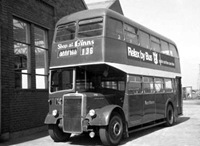 Vehicle reminder shot for this posting
Vehicle reminder shot for this posting
04/08/16 – 08:54
I lived next door to the depot at this time, and I’m sure that the buses parked at that end of the depot were awaiting disposal, which would excuse the missing foglight.
Stuart Gunn
09/08/16 – 06:18
I have an update to the discussion about the New Routemaster which took place in this thread two-and-a-half years ago, although actually it is also closely linked to the main subject matter of this forum, because the story really begins with the original Routemaster.
Readers may recall that, when the Routemaster was finally withdrawn from normal London service, an urban myth started circulating, to the effect that its open platform had been specially designed for London to allow passengers to board and alight between stops during periods of heavy traffic congestion. (This has resulted in anything with an open platform now being called a Routemaster.) Of course we all know that, in reality, getting on and off between stops is something that was always discouraged for safety reasons, until Boris promised to being it back in order to get elected as mayor.
Well the update is that next month – a mere four months after the end of Boris’s second term – the ‘platform attendants’ on the New Routemasters are to be dispensed with to save money, and the rear doors are to be kept closed between stops. What a surprise!
Peter Williamson
09/08/16 – 09:23
And what a criminal waste of public money on a preposterous vanity project.
Roger Cox
10/08/16 – 05:54
It’s probably partly political, with a Labour Mayor in post, to dismantle one bit of the ‘Boris Legacy’, with a wish to get rid of his unattractive-looking buses, too, but that is a step too far! Politicians love these projects, Concorde being one of the most expensive for huge technical advances, but no direct benefit to more than a few rich and business folk.
Chris Hebbron
11/08/16 – 06:25
As one who has always thought of Concorde as being a simply beautiful design, I cannot bring myself to say the same about the New Routemaster.
Brendan Smith
Quick links to the - Comments Page - Contact Page - Home Page

